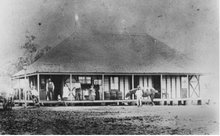My partner is very keen on sport and likes to keep me vaguely informed about important things as how the Packers are playing (American football), what is happening in the world of cricket etc. He has learnt though to pitch his stories the right way though. A few days ago he lured me into a sporting topic by dropping the fact that he had read that the Australia cricket
 team’s badges are the pre-Federation coat of arms, not our current coat of arms. I think this was a response to me calling the cricket website Baggy Blue instead of Baggy Green. A Baggy Green is the cap that Australian cricketers receive when they are selected for international competition. All the caps are numbered and once received are kept for the rest of the player’s life. In fact, in 2006, Cricket Australia decided that the Baggy Green image could be used on player’s graves.
team’s badges are the pre-Federation coat of arms, not our current coat of arms. I think this was a response to me calling the cricket website Baggy Blue instead of Baggy Green. A Baggy Green is the cap that Australian cricketers receive when they are selected for international competition. All the caps are numbered and once received are kept for the rest of the player’s life. In fact, in 2006, Cricket Australia decided that the Baggy Green image could be used on player’s graves.Intrigued as he knew I would be, I began to investigate. After all, it is the height of cricket season here so I am just participating in the seasonal culture. And it is indeed the case.
The first recorded cricket match in Australia was played in 1804 between the officers and crew of the HMS Calcutta in what is now Hyde Park in Sydney. By the 1830s there was a club competition in Sydney and by 1851, the colonies of New South Wales, Victoria and Tasmania were playing inter-state matches. The English team first toured in 1861 and the first international test match between England and the Australian colonies was played on 15 March 1877 (which by the way Australia won by 45 runs).
 As Australia did not exist as a country and the players were drawn from club players all over the continent, they had to come up with a badge. They chose to use a variation of the early coat of arms on their caps and offical blazers. That badge is used to this day, in spite of the existence of an official Federation coat of arms.
As Australia did not exist as a country and the players were drawn from club players all over the continent, they had to come up with a badge. They chose to use a variation of the early coat of arms on their caps and offical blazers. That badge is used to this day, in spite of the existence of an official Federation coat of arms.The official coat of arms can be seen here, but my personal preference is the elegant metal rendition gracing the front of the ACT Supreme Court. The twining branches are wattle and the designs on the shield represent the six states. The seven-pointed star represents the six states with an extra point for the Commonwealth territories.

I love the image below of the pre-Federation coat of arms taken from the cover of an album celebrating Federation. If you compare it to the picture of Adam Gilchrist wearing his Baggy Green, you will notice that the kangaroo and emu are reversed.

To put it in the context of my work. Australia and England were playing cricket in the period that most German migrants arrived. Most colonies had club competitions running so the Jaeckels might have seen people playing this strange game as they waited in Brisbane to select land. Most migrant children would have learnt the game playing in the backyards and on the school playground. Cricket in Australia has always been egalitarian and every little settlement would have had teams. Most of the towns in this area still do and generate players for state and even international competition.
It’s amazing how colonial history tinges the pages of today. I suspect that many fans and players would not even know the historical significance of the badges, but I am pleased that such an artefact of the past exists.

No comments:
Post a Comment